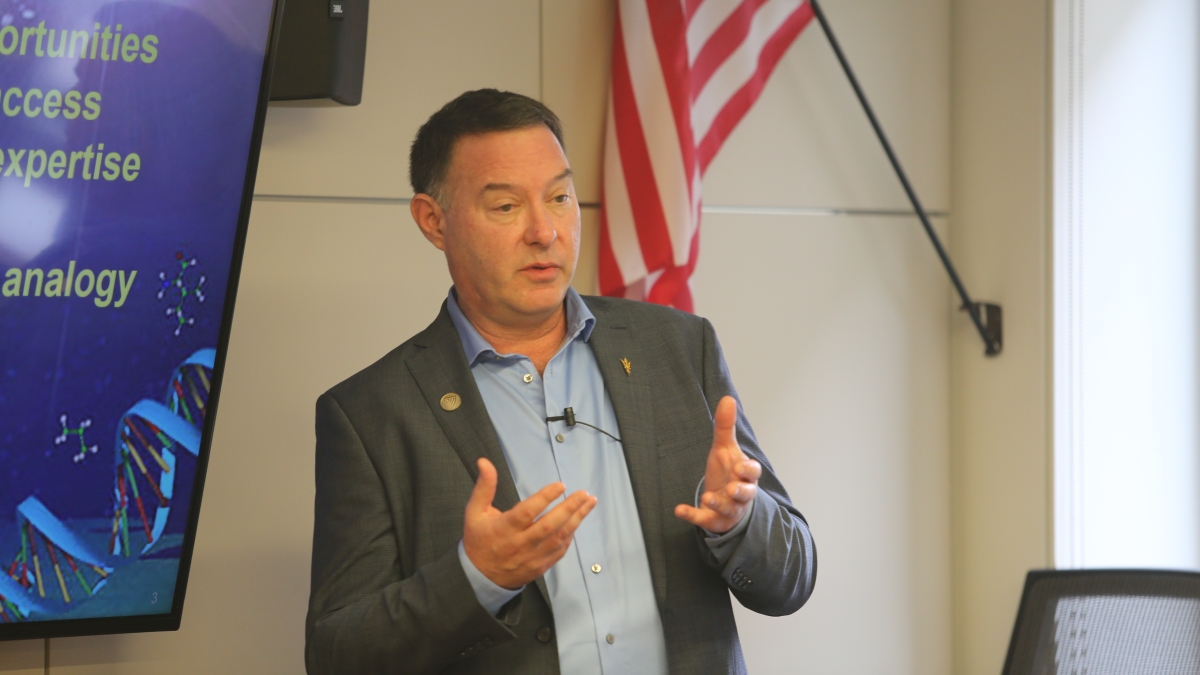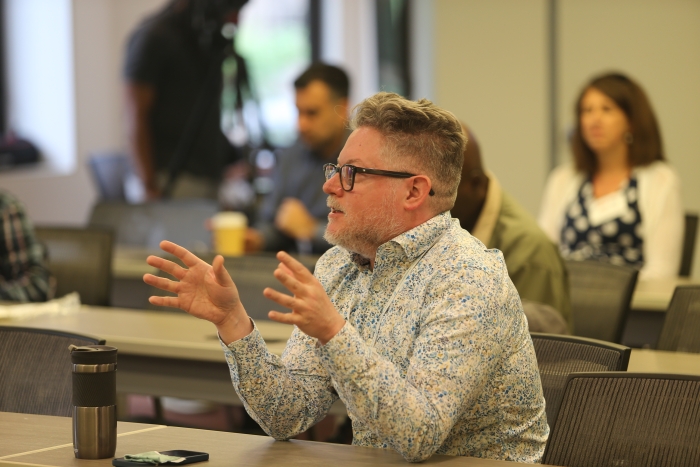ASU researcher Jim Bell on the benefits of opening space exploration to more countries

Jim Bell, planetary scientist and professor in ASU's School of Earth and Space Exploration, addresses the audience at an April 30 seminar at the Barbara Barrett and Sandra Day O’Connor Washington Center. Photo by Hager Sharp
On April 13, 2029, the Apophis asteroid will pass less than 20,000 miles from Earth, visible to the naked eye. The event may be a bit too close for comfort for some — the risk of a collision, however, has been ruled out — but the near approach will be a fantastic opportunity for astronomers to get an up-close look at this celestial body.
“This nearly four-football-field-sized chunk of rock is going to pass extremely close to the Earth,” Arizona State University planetary scientist Jim Bell said at an April 30 seminar at ASU’s Barbara Barrett and Sandra Day O’Connor Washington Center in the nation’s capital.
The potential scientific discovery is just one benefit, Bell said: The mission also offers promising opportunities for workforce development and the deployment of innovative technologies tailored for small asteroid exploration endeavors. It stands as a testament to international cooperation and scientific curiosity, added Bell, co-founder of ASU’s Milo Space Science Institute.
The significance of collaboration and capacity building in fostering the growth of the global space economy was a key theme of the seminar, titled “ASU’s Milo Space Science Institute: Increasing the World’s Access to Space.” Academics, policymakers and other guests learned more about the Milo Space Science Institute and the role it has to play by spearheading university-led missions that make space exploration accessible to countries around the world.
Established in 2018, the institute stemmed from a conversation between Bell and his colleague Lon Levin, who co-founded XM Satellite Radio. Frustrated by the setbacks and rejected NASA proposals, Bell and Levin shared their vision with ASU President Michael Crow, and together they outlined a plan.
“We talked about creating a way to increase opportunities, increase access and leverage the expertise that we have at ASU to do a lot of space missions,” said Bell. “We came up with an idea that is kind of an analogy … like a mini version of the European Space Agency.”
He added that the ESA organization, which has more than 20 member states, does amazing deep-space missions, but that the challenges encountered by both smaller space agencies across the globe and large agencies like NASA was an opportunity gap for them.
“The big space agencies are extremely conservative,” Bell said. “So, our idea was, let's try and level them up. Let's create an organization where they can participate, either through workforce development through payload development or mission development and get the experience.”
Bell particularly emphasized the necessity of fostering collaborations between universities, space agencies and private enterprises to broaden access and harness collective expertise.
“We're trying to fuse disciplines,” he said. “It's a partnership. It's entrepreneurial ... in that it's ... really something new and we're trying to have it be self-sustained. It's a nonprofit. And the idea would be just like with the European Space Agency, we build consortium of members who provide dues into a central organization — Milo, in this case.”
He went on to underscore the Milo Space Science Institute’s pivotal role in capacity building, particularly through initiatives like Milo Science Council, Milo Space Works and the Milo Mission Academy, which offers hands-on space-sector leadership training across several countries. Notable projects include NASA’s Lucy mission involving a workforce development program that incorporates online students from around the world.
The seminar was part of the ongoing “New Tools for Science Policy” series, hosted by ASU’s Consortium for Science, Policy and Outcomes. Watch the full video of the seminar on the CSPO website.
More Science and technology

Applied Materials invests in ASU to advance technology for a brighter future
For nearly 60 years, global giant Applied Materials has been hard at work engineering technology that continues to change how microchips are made.Their products power everything from flat-panel…

Meet ASU engineering students who are improving health care, computing and more
Furthering knowledge of water resource management, increasing the efficiency of manufacturing point-of-care health diagnostic tools and exploring new uses for emerging computer memory are just some…

Turning up the light: Plants, semiconductors and fuel production
What can plants and semiconductors teach us about fuel production?ASU's Gary Moore hopes to find out.With the aim of learning how to create viable alternatives to fossil-based fuels, Moore — an…


